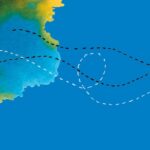Geographic Origins
The Republic of Turkey lies in south-eastern Europe and western Asia. It is bordered by the Sea of Marmara, Greece and Bulgaria, the Black Sea, Georgia, Armenia, Nackhichevan (a province of Azerbaijan), Iran, Iraq, Syria, and the Mediterranean and Aegean Seas.
History of Immigration and Settlement
It is thought that Turks were among the ‘Afghan’ camelmen who came to South Australia during the nineteenth century to transport supplies and primary produce in the colony’s arid interior. Cameleers were termed ‘Afghans’ by colonial authorities because of their similar, non-Anglo-Saxon appearance, their turbans and loose flowing garments, and their common adherence to Islam. For further information see the Afghan entry.
In 1891 there were 20 Turkish-born Australians. By 1911 there were 322. The number of Turkish Australians declined to 252 in 1947.
A number of Turkish Cypriots immigrated to South Australia between 1947 and 1967. As Cyprus was a British colony until 1959, many of these arrivals came to Australia using British passports. They immigrated to Australia because of a post-war economic slump in Cyprus. By 1966 there were 296 Turkish-born South Australians.
The number of immigrants coming to Australia from the United Kingdom, Ireland and western and northern Europe began to decline in the early 1960s. The Australian government began to seek immigrants from southern Europe and the Middle East. Turkey attracted the attention of Australian immigration officials because of its abundance of workers. Many Turks were living as ‘guest-workers’ in Germany, Austria, France and Sweden. In 1967 the Australian and Turkish governments signed an agreement offering assisted passages to Turkish people.
In the 1960s Turkish industry was limited to the western part of the country. Most of the immigrants who came to Australia immediately after 1967 were unskilled males and their families from central and eastern Turkey. Later arrivals had worked in the industries of western Turkey or were self-employed or professional people who emigrated from Turkey for political and economic reasons.
Turkish South Australians have immigrated to Australia from Turkey, Lebanon, Greece, Cyprus and Egypt. Turkish South Australians have settled throughout the metropolitan area and in Renmark. They are employed in a range of occupations.
Community Activities
The Turkish Association of South Australia (TASA) was founded by seven families in 1976. Niyazi Gures was the association’s first president.
In 1976 the association was registered as an official body. A language school and folklore group were established in the following year. In 1993, 40 students attended the school. They included children, adults who wished to learn Turkish for travel or business reasons, and Year 12 students. Currently classes teaching the Turkish language are held for two hours each Saturday during school terms at the Parafield Gardens Primary School, 23 Shepherdson Road, Parafield Gardens.
Belly Dance Elysium is a dance school in Adelaide which is also the official dance school for the Turkish Association of South Australia. The school teaches belly dance, Turkish folk and other Middle Eastern regional style dance to beginners and advanced students. There are also classes that teach Middle Eastern musical instruments. Belly Dance Elysium represents TASA at events such as OzAsia and the Adelaide Multicultural Festival.
The association currently meets from 2.00 pm to 6.00 pm the second Sunday of each month at the headquarters of the Multicultural Communities Council of South Australia, 113 Gilbert Street, Adelaide. Turkish related events and meetings are promoted on their Facebook site. Major events in TASA’s calendar are New Year’s Eve, Youth Day and Republic Day and the Islamic festivals of Ramazan Bayrami and Kurban Bayrami.
On New Year’s Eve the association holds a party at their headquarters complete with Turkish food and Turkish, Arabic and Middle Eastern music and dance.
Children’s Day falls on April 23. Youth Day is on May 19. Both these festivals celebrate the potential of young people, their hopes for a better world and their parents’ pride in them. Children’s Day and Youth Day are marked by barbecues or picnics.
Republic Day is celebrated on October 29. It commemorates the day in 1923 when Turkey became a republic. Sometimes members of the association give speeches or discuss the achievement of Kemal Ataturk who founded the republic. Ataturk means Father of the Turks. A community event honours the occasion.
The majority of Turkish South Australians are Muslims. For further information see Appendix 1, Religious Belief and Practice: Islam.
Organisations and Media
Turkish Association of South Australia
Adelaide Mosque Islamic Society of South Australia Inc.
Islamic League of Australia Inc.
Islamic Society of South Australia
Renmark Turkish Islamic Society
Statistics
The 1981 census recorded 619 Turkish-born South Australians.
The 1986 census recorded 559, and 467 South Australians said that they were of Turkish descent.
According to the 1991 census there were 559 Turkish-born South Australians. 1,078 people said that their mothers were born in Turkey, and 1,175 that their fathers were.
According to the 1996 census there were 558 Turkish-born South Australians, the second generation numbered 515.
The 2001 census recorded 593 Turkish-born South Australians, while 803 people said that they were of Turkish descent.
The 2006 census recorded 601 Turkish-born South Australians, while 886 people said that they were of Turkish descent.
The 2011 census recorded 623 Turkish-born South Australians, while 1,009 people said that they were of Turkish descent.
The 2016 census recorded 592 Turkish-born South Australians, while 1,204 people said that they were of Turkish descent.





Comments